Many volunteer and nonprofit organizations are familiar with the process of writing grants. Officially, a grant proposal is a request for money. But convincing funders to have the same stake in a cause as the grant writer does, and proposing it in a way that garners the right attention, can be a painstaking process. For this reason, grant proposals must be persuasive, well-stated calls to action.
Rather than thinking of grants as money requests, it’s essential to reframe your idea of them as an endeavor in advocacy. Genuine advocacy requires research and deliberate planning. Grant writers must carefully analyze the issue they’re addressing, identify how the funds can positively affect their organization, and communicate effectively with all the stakeholders involved. Learning how to write a winning nonprofit or volunteer organization grant proposal starts with understanding the importance of your project. It ends with establishing purpose.
This nonprofit grant writing guide will provide you with tips and actionable items to use for creating more successful grant proposals.
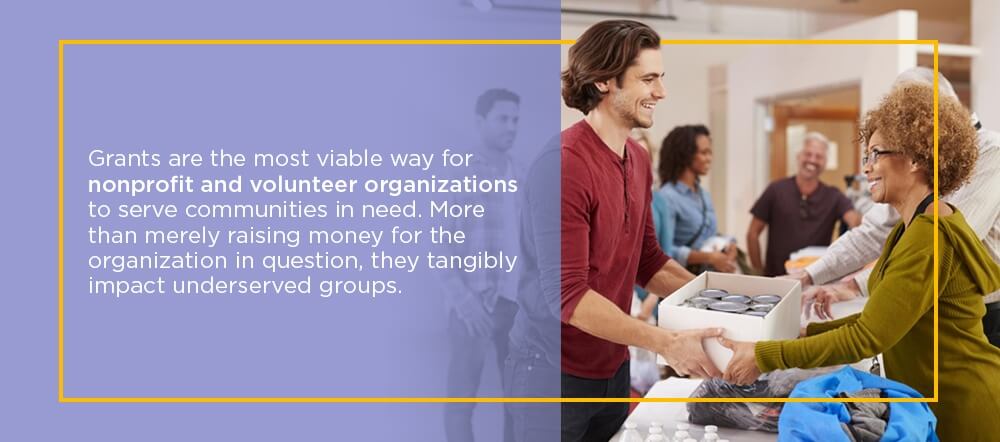
What Is a Grant?
Grants are monetary donations from government and non-government agencies — all encompassed under the term “grantmakers” — to eligible organizations. The United States has hundreds of federally funded grant programs offered across multiple agencies, while 82% of grant-seeking organizations received awards from private foundations in 2019.
Because grants are not loans and are awarded based on specific requirements and intended use, they are the backbone of nonprofit operations. Without grant funding, most nonprofits would struggle to meet their mission and gain visibility. That’s what makes knowing how to write a grant proposal so essential.
Many grantmakers have specific stipulations for which organizations can receive grants and requirements for applications and funds disbursement. Depending on the grant, nonprofits might receive funding in a single lump-sum payment, or the grantmaker may specify how and when the grant must be applied. These guidelines exist to help grantmakers ensure their monetary donations are put to the best use possible to meet a need or support a cause.
Grants are classified based on the source of the funds or how the nonprofit applies those funds. Examples of common grants for nonprofits include:
- Local, state, or federal government grants
- Private foundation grants
- Family foundation grants
- Public foundations
- Community funds
- Corporate grants
- Building or capital grants
- Niche or industry-specific grants
- General operational grants
Although most organizations offer funds to established nonprofits, some grantmakers may offer support for nonprofit startups. Nonprofits seeking grants should consider all possible revenues, including local resources, and consult experienced industry references to learn what could be available for them.
Why Are Grants Essential for Nonprofits and Volunteer Organizations?
Grants are the most viable way for nonprofit and volunteer organizations to serve communities in need. More than merely raising money for the organization in question, they tangibly impact underserved groups. For this reason, productive management of an organization requires professional skills, as the vested interest of outside parties influences their ability to fund that organization.
For an example of the importance of grants for nonprofits and volunteer organizations, look to the financial integrity the grant-giving sphere has amassed over the years. Since 1977, grant-giving has increased nearly every year, averaging a yearly growth of $8.94 billion. In 2017, charitable organizations obtained the equivalent of 2% of the gross domestic product, which equates to $410.02 billion.
The majority of grant-giving was on behalf of individuals, totaling a gift of $286.65 billion in 2017. Foundations, whether independent or community-based, came in second, with a combined gift of $66.9 billion. Given the positive trend of giving for financial grants, you should expect that in the coming years, there will be even more giving.
Note that grant-giving does not have a basis in need, but in merit. An organization may be struggling financially, but grant-givers need to trust that their financial contribution will go to an organization that can use it responsibly and effectively. To ensure that trust, grant proposals must prove their originating organization can take actionable measures to instill change in the community.
That makes grant writing for nonprofits and volunteer organizations equally as essential as the grant itself. Grant writing relies principally on two abstractions. The first is a holistic understanding of the nonprofit or volunteer organization grant writing process. The second is paramount — a successful grant writing guide with tips for writing a winning grant proposal.
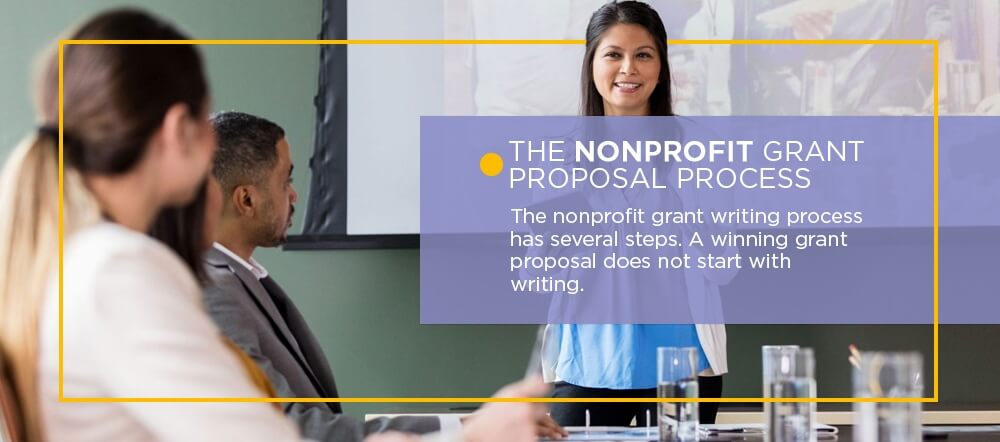
The Nonprofit Grant Proposal Process
The nonprofit grant writing process has several steps. A winning grant proposal does not start with writing. In the toolbox of tips for writing a nonprofit or volunteer organization grant proposal, you first learned the significance of a deliberate outlook. Therefore, you want to make sure you’ve covered all your bases before beginning to write.
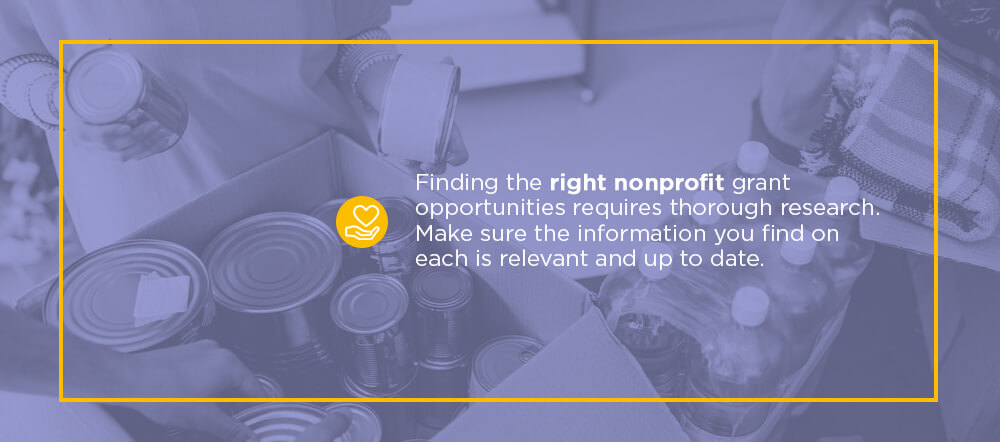
1. Find the Right Opportunities
First, you need to know how to identify grant opportunities. But this is not the same as finding any circumstance where money is in the picture. One tip to remember for nonprofit grant proposal best practices is to focus on identifying the ideal nonprofit grant connections. While this can be subjective, it’s most advantageous to seek things that closely align with the objectives of your organization.
Finding the right nonprofit grant opportunities requires thorough research. Make sure the information you find on each is relevant and up to date. Another tip is to direct attention to resources in your community before branching out more widely. Close-knit relationships foster confidence among locals for your organization.
There are many ways to select grant opportunities online. For federal grants, there is a centrally located website, conveniently named Grants.gov, which offers a quick way to search through a slew of federal funding. Here, you’ll find nearly 900 programs from 26 different federal agencies that award $350 billion altogether each year. Instead of federal grants, you can check out Candid — formerly called the Foundation Center — for similarly helpful information on private funders.
2. Understand the Requirements
After finding the opportunity you wish to write a grant proposal for, you should pay close attention to its requirements. Each proposal request will require you to meet guidelines. Request a copy of these, if possible. The requirements for a grant can be somewhat specific, but they are often warranted. You do not want to spend valuable time applying to a grant for which your organization is ineligible.
A common eligibility requirement, for example, might pertain to the specific type of organization you have. Some grants exclusively apply to particular organizations. Religious and educational charities seem to receive the most funding, receiving $127.9 billion and $58.9 billion, respectively, in 2017. To compare, environmental organizations received the least funding, at only $11.83 billion. Depending on your organization, securing a large fund amount and finding fitting opportunities may be more or less of a challenge. Of course, there are different ways for organizations to meet their goals.
3. Learn What’s Necessary
Other than eligibility requirements, the grant may require you to submit specific documentation or some other components with your application.Each funder will have a precise list of requirements necessary for your grant application. Many grantmakers ask nonprofits to submit a letter of inquiry (LOI) before presenting a full proposal. In these cases, you’ll provide a short letter with a condensed version of your proposal. If the grantmaking institution is interested, they’ll invite you to submit a full proposal. It’s crucial to study the application process and requirements for each funder.
Corporate grantmakers usually require proof of 501(c)3 status. Most will ask for a Tax Exempt Number or an IRS letter of determination, while others need a completed W-9 form. Many foundations will ask you to include an employee sponsor from within the corporation you’re seeking funding from. Even when it’s not a requirement, demonstrating a connection to the company may strengthen your application.
Meanwhile, federal grant applications require you to send several forms along with them.
The SF-424 form, for one, is a standard form deployed as a cover sheet for the rest of the application. Some entries the form requires are submission type, application type, areas affected by the project, and the name of the federal agency to which you are applying. You must also submit regular performance progress reports and document the lifespan of a project.
Two other forms are typical, but not always static in their execution. The SF-425 report is a federal financial report detailing the financial status of an agreement with the federal agency and the organization at predetermined intervals. Form 270 is for fiscal advances or reimbursements.
4. Plan the Process
As with any process, you should make an intentional plan for how you’ll want to write the grant proposal for your nonprofit or volunteer organization. That includes the process of filling out and filing the application and all subsequent steps for approval or disbursement.
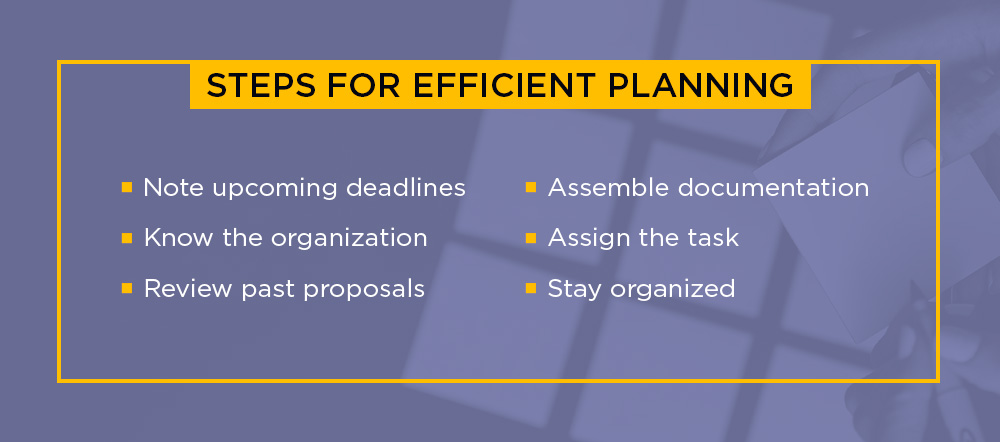
Keep these steps in mind for efficient planning:
- Note upcoming deadlines: Be especially aware of upcoming deadlines. Part of this awareness should consist of fully comprehending the work you have set out for you and your organization. Creating a calendar to hold yourself accountable could be useful. But this schedule must correspond to your organization’s timeline of future events and commitments.
- Know the organization: Be mindful of the organization’s budgets and any adjustments that can or may need to occur so you’re prepared if they request additional documentation or information about your grant application. Knowing the organization is also a good way to gauge your likeliness of receiving funding and whether you should continue applying elsewhere.
- Review past proposals: Review your past grant proposals to plan accordingly. When applying for the same grant, these will help give you an idea of how much funding you’re likely to receive and how much time the application process took. You can grasp the outcomes of new grants you’re applying to based on this history.
- Assemble documentation: Gather all the necessary documentation and information you need before you start the grant writing process. This will prevent delays or unexpected hiccups as you apply.
- Assign the task: Are you writing your own grant, or will you seek third-party help from a professional grant writer? Both options have merit, and the best results often combine external expertise with an in-house delegate or grant team. Delegating tasks early will help you create a more accurate timeline and keep all relevant parties informed throughout each step.
- Stay organized: Keep separate digital and physical files for each grant application and proposal you submit. Each should have its own timeline with relevant dates noted where it’s easily accessible.
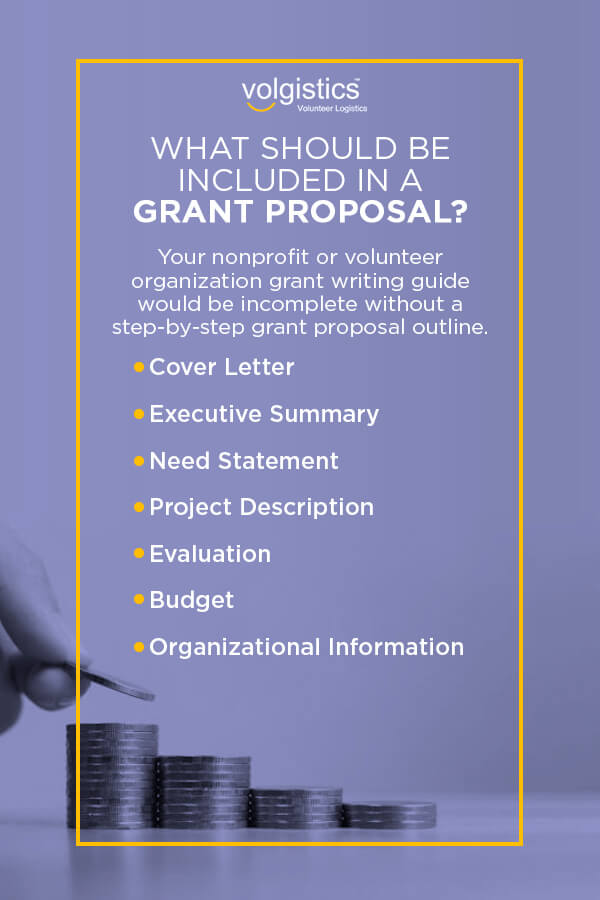
What Should Be Included in a Grant Proposal?
Your nonprofit or volunteer organization grant writing guide would be incomplete without a step-by-step grant proposal outline. Rather than providing a curt debriefing of some nonprofit grant proposal tips, this grant proposal guide makes an effort to address the needs of all grant writers asking themselves, “How do I write a winning grant?”
Cover Letter
A cover letter is a brief introduction to establish your connection with the potential grant-giver. Summarize the surface interests of your proposal and the context of your organization. Though short, your cover letter is the funder’s first impression of you and your organization. Aim to give the letter an enthusiastic tone and show appreciation for the funder’s consideration. Present your organization’s character through your writing, but also demonstrate your professionalism.
Executive Summary
The executive summary is the first official part of your grant proposal. This component is a short overview of your proposal, similar to the cover letter, but more pointed. It is similar to the abstract of an essay or research paper. Some guides to writing grant proposals recommend that the executive summary only be a few sentences. Others recommend two to three paragraphs, so long as the summary doesn’t extend past one page.
Your executive summary should inform the reader that your proposal fits the funder’s guidelines. It also allows you to capture the reader’s attention from the get-go. Explain the crucial aspects of your proposal, such as background and relevance. Sometimes the funder will ask for other sources of funding as well, which you can mention in the summary if applicable.
For organizational purposes, you can think of the summary in three parts:
- Part one: The problem, a statement of the need, or issues your organization is addressing
- Part two: The solution, where you should be describing what needs to take place to resolve the issue
- Part three: Elaborate on the specific funding requirements that should aid the resolution
Although the executive summary comes at the beginning of the proposal, many writers save it for last, along with the cover letter. That way, you can better encapsulate the pivotal points of the proposal.
Need Statement
The statement of need is where you’ll have to use your advocacy skills. The need statement aspires to make a strong argument for the problem you’re addressing. Support your argument with factual information and evidence that will convince the funder that your project is essential. Several integral factors have a critical role in your statement.
Start by defining the purpose of your proposal. Identify beneficiaries and their distinctive benefits. Stress the socioeconomic effects of the project and to what extent your organization is familiar with the problem. Emphasize how the funder can alleviate the problem and the consequences of limited funding. Convey your argument with a sense of urgency and authority. The need statement should be two pages at most.
Project Description
Describe your project in a way that is compelling to the reader. The project description grounds the funder in reality by contributing quantifiable goals and objectives, in conjunction with a means of delivering them. This section’s vision is to present information both tangibly and feasibly.
- Goals and objectives: Delineate goals directly related to the needs you have defined. What are your desired outcomes? What do you hope to achieve given the requested budget? These are the type of questions to answer here. Home in on the results of the project, and do not propose methodologies just yet.
- Methods and strategies: Lay out how you will follow through with your goals and objectives. This section can provide a detailed explanation of the activities you will designate toward attaining the outcomes you’ve described. What specific resources will your organization devote to this project? When do you plan on reaching your goals? Assure your funder that you have practical objectives in mind by answering these questions in depth. You can use a diagram to demarcate the specific staffing and resources you will use to accomplish your objectives.
Evaluation
Sometimes referred to as a plan of evaluation, the evaluation section expands on the methods and strategies section, setting forth an approach to measuring progress and performance within the established timeline. Funders are keen to know just how their money made a difference. Specify how you will collect meaningful data.
You can enlist a third party to help you record data and decide on the optimal methods for measurement. Be meticulous in your measurements. You should complete a product evaluation that can appraise whether the project meets its objective. You should also plan on conducting a process evaluation recounting how your organization managed the project and if it was consistent with your stated plans.
Budget
Summarize the direct and indirect expenses of the project. Organization personnel, overhead, project monitoring costs, and supplies are a few examples of what your budget might entail. Consider breaking up your budget into personnel and nonpersonnel expenses. A spreadsheet is a good medium for this. For personnel expenses, chart the following:
- Salaries
- Benefits, such as health care and retirement plans
- Contract services, like consultants
Nonpersonnel expenses could look like this:
- Costs for leasing and using rental space
- Utilities
- Equipment purchases
- Operational training
- Travel
The nature of your project will determine the degree of specificity you can provide, but funders are sure to regard meticulous grant proposals with the highest esteem. The budget should indicate that you intend to use funding wisely and with caution.
Organizational Information
It’s not rare for funders to look for more information related to the history, mission, and people behind your organization. These details aren’t usually mandatory, but they can be conducive to your efforts. You’ll need to know how to write a mission statement for your grant proposal for insertion at the end. This statement will highlight your organization’s readiness to carry out the project.
5 Tips for Writing a Winning Nonprofit Grant Proposal
Even with a distinct outline, incorporating every endorsable step in the above guide for how to win a grant can be arduous without some fundamental tips. Recall that knowing how to write a nonprofit grant proposal demands much more than writing alone. Among other things, it requires deliberation and smart decision-making. Here are some effective grant writing tips for nonprofits.

1. Get the Right People
Perhaps the most salient of these grant proposal writing tips is to involve the appropriate people in your project. In your grant proposal, you’ll have to lead funders to believe that your organization has the right tools to influence the community and generate genuine social and economic changes. The people in your organization should either have experience in shaping lives or in fundraising.
See to it that you have a worthy team filling the positions you need for organizational leadership, board membership, or whatever it may be. Select few, but robust, forces for this team. The right people should make an impression on productivity to the effect that you won’t need a large group at all. You can rest assured that everyone around you has the same goals.
2. Have SMART Goals
Again, your goals should be quantitative. One way to ensure an effective goal-setting process is to use the acronym SMART, which stands for:
- Specific
- Measurable
- Achievable
- Realistic
- Timely
When writing objectives for your grant proposal, do not generalize your intentions or how you plan to realize them.
How can you be sure your project will effectively respond to the problem you have defined? This question is another that — when answered precisely — can guide your writing to be as unambiguous as possible.
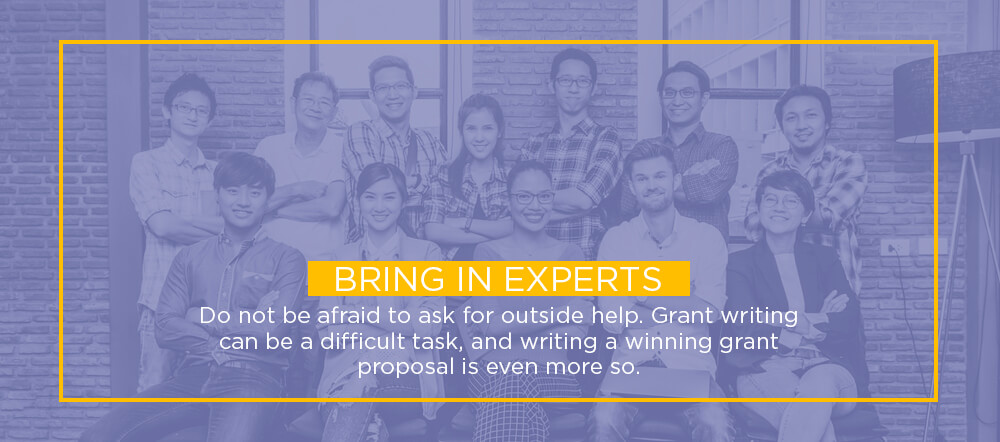
3. Bring in Experts
Do not be afraid to ask for outside help. Grant writing can be a difficult task, and writing a winning grant proposal is even more so. Consider hiring a professional writer, but watch out for scammers. Use the Better Business Bureau to verify credentials. Browse the American Association of Grant Professionals to get in contact with an expert grant consultant.
Government grants tend to be more complicated than the norm, and professional assistance can be incredibly beneficial if you’re applying for federal funding. If for some reason your organization decides not to use any consultant or specialist for grant writing, you do have the option of hiring an editor to review a written proposal.
4. Give Anecdotes
Factual evidence is a must for writing any grant proposal. You need to back up your cause with credible information. That said, alongside the facts, you’re also free to do some storytelling. Providing your funder with an interesting anecdote as part of your evidence will elicit pathos from the reader.
Pathos is a method of affecting the audience by using an emotional appeal. Grant writing may be a methodical process, but a grant in and of itself is a demonstration of care. Enforce that narrative with your writing.

5. Follow the Guidelines
Provide exactly what the grant guidelines require. Doing any less will negate your chances of winning the grant award. Doing any more could lead to the same consequence. Bypass this complication by following guidelines to the letter. But write persuasively and with intent. Rely on the support of a competent guide like this one.

Work With Volgistics
Data is an integral part of the grant writing process. When showing grantmakers what your organization does, it can be helpful to provide a few facts and figures. Volgistics allows you to collect critical data about your organization’s volunteers.
Whether you want to highlight your total annual volunteer hours or the number of meals delivered by your volunteer team, Volgistics makes these measurements easy to track and report. You can even frame data to estimate how the dollar amount of a grant might make an impact. Volgistics lets you track up to 14 measurements according to your organization’s needs. Build your volunteer management software into your grant proposal’s plan of evaluation.
Besides writing grants, volunteer organizers and nonprofit leaders are responsible for managing quite a few people. Whether it’s recruiting, training, or supervising the people within your organization, you have major responsibilities to address. At the same time, you’re likely also involved in tracking hours and opportunities, writing reports, and handling a plethora of other administrative tasks that can sometimes be exhaustive and time-consuming. To prioritize your time efficiently, consider passing on these duties to Volgistics.
Volgistics is a professional volunteer management service that’s both budget-friendly and highly customizable. Working with Volgistics drastically reduces the time you spend working on the technical aspects of your organization, so you can concentrate on the people that fuel your work. With the help of Volgistics, you can have a focal point for storing data, tracking scheduling and requirements, and communicating important messages. Volgistics also has a means of making user-friendly custom reports. With Volgistics, there are no contracts or startup fees, and you can start a trial within minutes. Try a free trial today.

